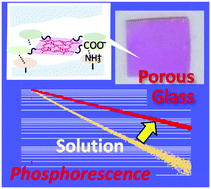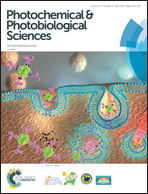Enhanced phosphorescence properties of a Pt-porphyrin derivative fixed on the surface of nano-porous glass†
Abstract
The room-temperature phosphorescence chromophore, Pt(II) coproporphyrin I (PtCP), was fixed on the surface of a 3D-network of nanoscale pores of porous glass through ion-exchange reaction. The absorption and phosphorescence spectra indicated that PtCP can be loaded while maintaining monomeric dispersion at concentrations well beyond solubility limits of PtCP in solution. The phosphorescence quantum yield of PtCP fixed on the surface was also found to have double the enhancement of solution. The extended lifetime of phosphorescence of PtCP bonded on the surface compared to that in solution clearly indicated that suppression of nonradiative deactivation plays a key role in high quantum yield and long triplet lifetime. This hybridization with nano-porous glass provides opportunities for various potential applications.

- This article is part of the themed collection: 28th International Conference on Photochemistry (ICP 2017)


 Please wait while we load your content...
Please wait while we load your content...